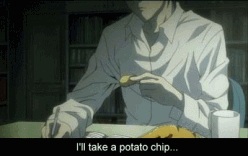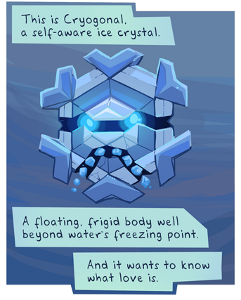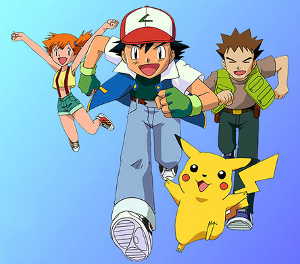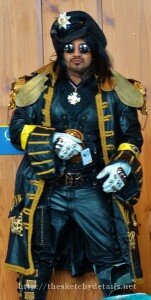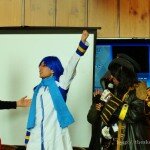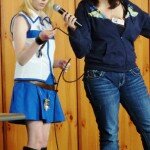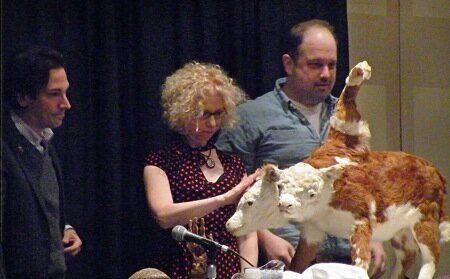I had a hole in my schedule over the weekend and that was supposed to be filled with convention coverage. That’s when I did a quick search online and found out about Quinni-Con. This is a Japanese culture and entertainment convention run by the Quinnipiac University Anime Club in Connecticut. I wasn’t sure what to expect other than a free convention within reasonable driving difference. It turned out to be so much more.

(click to enlarge all photos)
I firmly believe that you can tell a lot about the people running a convention by how well it turns out. If they’re only concerned with turning a profit and their bottom line, you usually wind up with an over-crowded expo show where you can’t even enter the dealer room without being hit by 20 people at the doorway. If they are focused on star power alone, you’ll have a signing room with great guests and a pretty tepid schedule of panels and outside events. However, if they focus on the needs of the fans attending the convention, you wind up with a really smooth and relaxed environment with a ton of diverse content and easy access to food, seating, and open spaces for photos and meet-ups.

hashtags galore
Quinni-Con 2013 is one the best small conventions I’ve been to. This was only their second year putting on the event and it far exceeded my expectations. The entire convention was confined to the student center and they made the most of the space. Registration, Dealer’s Alley, food, seating, the main stage, and the Maid Cafe were all on the bottom floor. The two panel rooms, a video game room, a roleplaying room, raffles, and a screening room were all on the second floor. Even with the Quinnipiac students coming and going to the cafeteria and gym all day long, Quinni-Con never felt crowded or overwhelming.

The Asterplace drove the crowd wild with great cover songs
I spent my time at the convention panel and event hopping like I always do. It was hard to choose what events to go to. I could have spent most of my day at the main stage, taking photos and videos of the copslay contest, Anime Jeopardy, and even a concert from The Asterplace (a NYC-based Tokyo rock/anime cover band that always puts on a great show). But that would mean skipping panels on creating abridged parody series, how voice acting works at Funimation, bizarre fan theories about
Adventure Time, the basics of anime-style art, and the philosophy of
Pokemon. And if you just hop from panel to panel, you have to skip out on video game contests (how I wish I could have taken on all challengers in
Super Smash Bros. Melee where Jigglypuff is still a viable contender), anime screenings, improv games, the Maid Cafe, and just hanging out with other fans.
I did catch a lot of diverse content that I’ll be covering more in depth throughout the week. Here’s a run-down of what I did at Quinni-Con 2013.
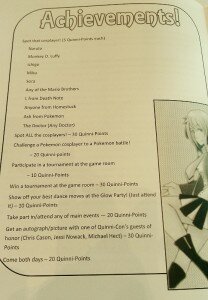
45 points for me
I arrived a few minutes past 9AM, so I missed the opening ceremony. I took a good amount of time to go through the program, familiarize myself with the layout, and plan out my day. This was where I first noticed the total fan-focus of the convention. One page in the program turned Quinni-Con into an interactive event. You earned points for spotting cosplay (5 points for Luffy), participating or attending main stage events (20 points), and even points for total fanboying (20 points to challenge a Pokemon cosplayer to a battle). I spent a few minutes chatting up vendors before heading up to a panel on abridged series run by the creators of Pokemon Bridged.

Misa from Death Note cosplay
When I tried to get back to the main stage for Cosplay Candidate, a fantasy-tinged political debate between various attendees playing their cosplay characters, I realized how big Quinni-Con actually was. The place was packed. The tables were all filled, so I quietly made my way to the back of the room to set up for coverage. The crowd was constantly interacting and the host, Steam-Funk Studios’ A Count Named Slick Brass, was eating it up. The sizable base of
Homestuck and
Hetalia: Axis Powers fans cheered their own right into the finals.

The Ice Queen ran a panel and placed in the cosplay contest
After a quick break to refuel and talk to the staff, I spent a lot of time with fans at the con. One panel, Theory Time with Ice Queen and Gunter, was a big interactive moment of
Adventure Time fans debating everything from the history of the Mushroom Wars to the true identity of Princess Bubblegum. The cosplay contest saw the fans continue their domination of the day with a wild response to every participant.

Liechtenstein from Hetalia cosplay
From there, we hit full on Sketchy Details territory with panels on Funimation’s production process hosted by voice actor/director Chris Cason, voice acting on the Internet, the art of anime, and the philosophy of Pokemon. Even in the more structured panels, the fans attending the convention wanted their voices heard. The beauty of a smaller convention is that you will get a chance to interact if you choose to. Each of the panel hosts took on all questions, joked around with the audience, and encouraged debate. This is what fan culture is all about.
With a 90 minute drive down my choice of poorly-lit highways ahead of me, I ducked out of Quinni-Con at 7PM. Had I had more time to plan, I would have a way to stay later and return for day two, as well. Maybe next year.
I cannot say enough nice things about Quinni-Con 2013. I had a few minutes to talk with convention chair Amaris Mujica about how everything was going. She was clearly excited. The staff did not anticipate such a large turnout. She was open about the problems with the convention, but, honestly, it was so well run that the minor issues–running out of programs, having very limited space for the artists and dealers–didn’t hurt the experience at all.

The line was out the door to register for Quinnicon by 9:30AM
If every con was run with as much passion for the fans and organization as Quinni-Con, writers wouldn’t need to write long screeds explaining what went wrong after every major convention. We wouldn’t walk away opting not to cover greedy conventions with rude staff and not enough events for the ticket price. And we certainly wouldn’t need to worry about whether or not we’d have to walk 10 blocks away to buy a reasonably priced sandwich and bottle of water to make it through the day.
If you’re in the greater Connecticut area and like anime, I strongly encourage you to seek out Quinni-Con next year This is a convention to watch out for in the future. A lot of people are posting about their Quinni-Con 2013 experience at the 2013 Facebook event page. They even started a Facebook group to keep in touch as they plan for next year.
Thoughts on Quinni-Con 2013? Share them below.

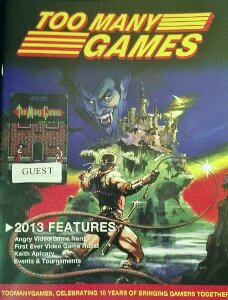 When I applied for the convention, I didn’t realize that the schedule for the camp I teach theater at was set for back to back training weekends. I thought there was a gap in between. I was wrong.
When I applied for the convention, I didn’t realize that the schedule for the camp I teach theater at was set for back to back training weekends. I thought there was a gap in between. I was wrong.
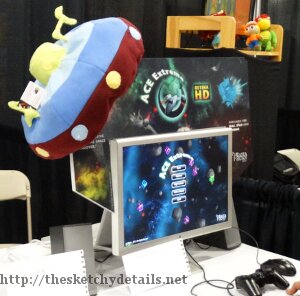











 I walked into the convention hotel and got all my gear ready to go to my first panel. I just needed to find where it was. I looked at the schedule and it said to go to room 2. I decided to locate all the panel rooms listed on the map so I would know where to go all weekend. 1, 2, and 3 were found without issue. 5 and 6 were a bit more problematic; there was no room 6. Room 5 was switched to 4 and Room 6 was switched to 5. All I heard when going to panels that day was confused people trying to find the mysterious Room 4 that wasn’t on the convention map. There were also unlabeled workshop rooms and the decision not to distinguish between Main Events A and Main Events B on the schedule.
I walked into the convention hotel and got all my gear ready to go to my first panel. I just needed to find where it was. I looked at the schedule and it said to go to room 2. I decided to locate all the panel rooms listed on the map so I would know where to go all weekend. 1, 2, and 3 were found without issue. 5 and 6 were a bit more problematic; there was no room 6. Room 5 was switched to 4 and Room 6 was switched to 5. All I heard when going to panels that day was confused people trying to find the mysterious Room 4 that wasn’t on the convention map. There were also unlabeled workshop rooms and the decision not to distinguish between Main Events A and Main Events B on the schedule.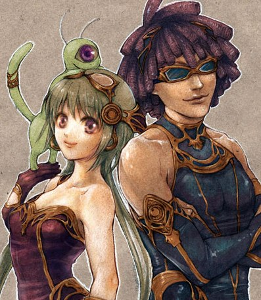 My next big event was the Opening Ceremony. I looked up some videos from previous years and was excited to get some photos and film the event. I had a huge video planned that was going to represent fan culture at AnimeNEXT 2013 with clips from the big events, photos, and interviews with cosplayers and attendees. I knew that wasn’t going to happen before the hour-long Opening Ceremony was finished.
My next big event was the Opening Ceremony. I looked up some videos from previous years and was excited to get some photos and film the event. I had a huge video planned that was going to represent fan culture at AnimeNEXT 2013 with clips from the big events, photos, and interviews with cosplayers and attendees. I knew that wasn’t going to happen before the hour-long Opening Ceremony was finished. I feel fortunate that I got to the event right when it opened at 7PM. By 7:30, you couldn’t walk around anymore. No Quarter drew a huge crowd of enthusiastic gamers and writers with the promise of free games and free refreshments. What more do you need at a one night only arcade?
I feel fortunate that I got to the event right when it opened at 7PM. By 7:30, you couldn’t walk around anymore. No Quarter drew a huge crowd of enthusiastic gamers and writers with the promise of free games and free refreshments. What more do you need at a one night only arcade?


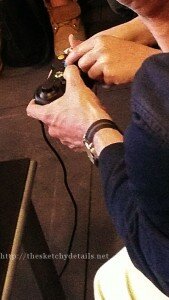

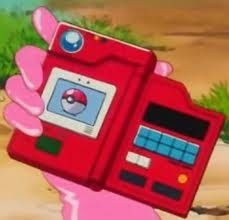
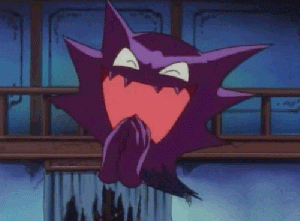
 When Funimation secures a license for a new show, they put together their in-house creative team. As many as seven separate shows are being worked on in different studios at a time with an regular work schedule of 10AM to 6PM. The director is given the translated scripts, character descriptions, and images from the show. However, they’re in charge of researching the show and influences to figure out the crux of the series. They plan for as long as the production schedule allows them so they can figure out the right tone and approach for the translated program.
When Funimation secures a license for a new show, they put together their in-house creative team. As many as seven separate shows are being worked on in different studios at a time with an regular work schedule of 10AM to 6PM. The director is given the translated scripts, character descriptions, and images from the show. However, they’re in charge of researching the show and influences to figure out the crux of the series. They plan for as long as the production schedule allows them so they can figure out the right tone and approach for the translated program.

